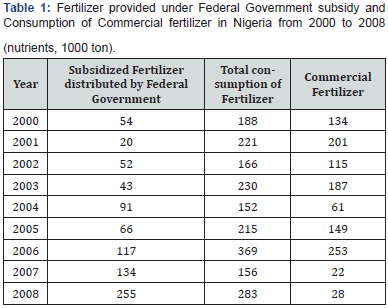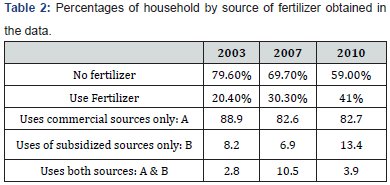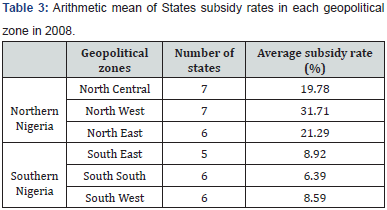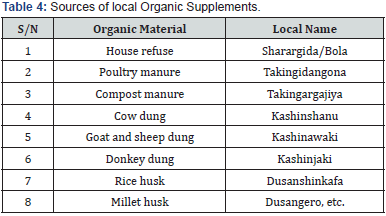Juniper Publishers-Agricultural Pollution: An Assessment of Synthetic Fertilizer Application in Sudano- Sahelian Zone of Nigeria
Juniper Publishers- Open Access Journal of Social Sciences & Management studies
Introduction
This study entails about agricultural pollution and
assesses the synthetic fertilizer application in Sudano-Sahelian zones
of Nigeria. Nigeria is Africa’s most populous nation with an estimate
population of 140.0million people according to 2006 census conducted by
Nigerian Population Commission but increased to an estimate of 189.6
million people as of 1st January 2017 (UN Department of
Economics and Social Affairs: Population Division). The population is
rapidly increasing due to high birth rate and low death rate. Fertilizer
use and needs vary across Nigeria depending on agro ecological
conditions, government policies, cropping systems and fertilizer
responsiveness. Nigeria has one of the most promising agricultural
potential which is yet to be realized. From the year 1960 to 2005, it
cereal production per hectare has only grown by about 40 per cent. This
is small in comparison with countries like India ‘grown by about 150 per
cent’ and Pakistan ‘grown by about 200 per cent’ since they have
similar level of productivity at the beginning of that period.
As regard to the rate at which the Nigerian
population is increasing, the cropping system remained the most vital
source of income to the millions of people besides providing food and
shelter. The country has been long importing staples like rice, maize
and cassava but in efforts to encourage local production had now placed
ban rice importation [1]. With regards to this, the soil is the most
vital component of human economic development through crop productions
as reported by Usman (2013). Decline in soil fertility and quality are
among the main factors that affects the agricultural activities beside
erosion and desertification [2]. The decline in soil fertility and
quality was largely affiliated to poor agricultural practices and
insufficiency of other nutrient to support good growth and development.
These threats necessitate fertilization as the most vital option
available for farmers to maximize their crop productions, minimized and
possibly reverse these dreadful environmental hazards.
The study encompasses the Sudan and Sahel Savanna
region of northern Nigeria that lies within latitude 11oN and 14oN. This
region historically provided higher Fertilizer subsidies than their
southern counterparts since during the colonial era when administrations
provided support for fertilizer use due to the concerns poses by soil
depletion and desertification, Mustapha (2003). The soil of this region
has low fertility and buffering capacity, FFD, 2011-Smith et al. (1997).
The use of synthetic fertilizers on continuous basis and in substantial
quantities has always been of much concern among experts and decision
makers, Olaitan et al. (1984). Millet, sorghum, cowpea, groundnut
and sesame are the major cereal crops grown in this region.
Experts are familiar with the eventualities resulting from the
use of this chemically made fertilizers and other agrochemical
in conventional form of agriculture which destroyed the national
settings of our environment and lead to many deadly diseases.
The present study aimed to give a snapshot of the situation
regarding the synthetic fertilizer application within the study
area and give a diagnostic view, recommends the formulation
of effective policies, and promotion of cordial collaboration and
monitoring of progresses through explaining the economic values
and environmental benefits of organic fertilizer application.
However, the study area receives rainfall only seasonally with a
very highly pronounced dry season. Farmers apply more fertilizer
to accelerate growth of the plant in order to meet their net return
and profits. There is an essential need for using fertilizer either
organic or inorganic and also an obligatory need for adopting a
sustainable method of application.
Review of Related Literature
This present study assessed the farmer attitudes toward
the intensive application of synthetic fertilizer in the Sudano-
Sahelian zone of Nigeria. Just as animals must have certain vital
nutrients in their food for proper nutrition to promote excellent
growth and good health, the plants also required certain mineral
nutrients in the soil and air too. These Plants absorb most of
these essential nutrients through their roots and foliage’s. On the
other side, many soils do not have sufficient nutrients to support
good growth and development. In highlight of major an issue,
the former UN Secretary Kofi Anan called for a strategy to bring
food security to Africa pointing out that Green Revolution had
triple food productivity in Asia. Such called and the likes led to the
African Fertilizer Summit. This is the largest meetings in history to
focus on Africa’s food issues.
The “Fertilizer summit” took place in Abuja Nigeria, June 2006.
In attendance are the African head of states, Ministers, Policymakers,
NGO’s and Leaders in the private sector. The prime aim of
the summit is to “discourse the urgent negative trend in fertilizer
use and food security in the continent”. Nagy and Edun (2002)
report that during the early 1970’s, there are evidence of low
fertilizer application in Nigeria despite effort from both the State
and Federal Government to subsidies fertilizers, sometimes at rate
as high as 95 per cent but by the year 2005, fertilizer consumption
is 7 per cent kg/ha of arable land which is visibly lower than the
Indian rate of 121kg/ha and Pakistan’s 184kg/ha as reported by
World resources Institute [3].
In Nigeria, fertilizer subsidy accounted for 30 per cent of the
Federal Ministry of Agriculture budget even though only 3 per cent
of the total annual budget is allocated to Agriculture, Mogue et al.
(2012). The Government established a program in 1999 known
as “Federal Market Stabilization Program FMSP” that lasted
until 2011, Shima (2013). This program has the responsibility of
accepting state request of fertilizer based on demand projections
of their respective states (both subsidized and unsubsidized). In
view of this, it promotes greater access to synthetic fertilizers.
Methodology
The analysis in this paper is based on secondary data collected
by the authors on the nineteen (19) states of Northern Nigeria
been situated in Sudan and Sahel Savanna zones respectively. The
study employed descriptive statistics using appropriate statistical
analysis techniques. Comparisons are made against the obtained
results with the goal set to achieve by the present study for proper
validation.
Study Area
This study relied on Sudan and Sahel Savannah region of
Nigeria where rainfall occurs only seasonally but often intensive
when it does come. The region has rainfall period of 4-5 months
annually (begins in May, peak around august and end October).
The main two distinct agricultural lands in this region are the
dry land and Fadama. The dry land is characterized by high sand
particle, low organic matter and the soil is washed away easily by
high rainfall, Mortmore (1989), whereas the Fadama is dominated
by alluvial clay particles characterized by high water holding
capacity, Kparmwamg et al. (1990).
The region is believed to have covered 75.9 per cent of the
Nigerian landmass and about 57 per cent of this region is believed
to be under Agricultural activities ‘either under crop productions
or pasture’ [2]. It is estimated that more than 70 per cent of the
population of the region depend on agricultural activities for their
livelihood and sources of income (Nigeria, NBS 2008 and 2010),
CIA (2009). The region comprises of nineteen different States
in Nigeria. As of 2008, about six different states have functional
synthetic fertilizer blending plants (Bauchi, Borno, Gombe, Kano,
Katsina and Zamfara State) and another six have nonfunctional
plants (Yobe, Kebbi, Nasarawa, Niger and Sokoto State).
Oluwale [4], reported that about 98 per cent of the farmers
in the Sudan and Sahel Savanna region used synthetic fertilizer
as supplement but it intensive application depend on farm size
and socio-economic standard of the farmers. The smaller farms
holders tend to apply more fertilizer than the larger farms.
Moreover, it is reported that small scale farmers uses fertilizer
more intensively than the large scale farmers within the study
area. However it is evident across the region that the population
of small scale farmers constitutes the majority among the existing
farmers.
The soil of northern Nigeria is the most important area for
the production of varieties of cereal crops, legumes, vegetables,
tubers and so on [5]. Consequently this region more recently
complained about decline in production, decrease in soil quality
and fertility. These threats forces farmer’s to seek for available
options to supplement the declining nutrients. Many farmers still
has a popular believe that organic fertilizer remained scarce and
sometimes unavailable. And see the synthetically made fertilizer’s remain the only option since it is available, abundance and
relatively cheap. Farmer’s believed that use of this supplement
will always result to good agricultural return and also maximized
profit margin. (Table 1-3), (Figure 1).





Based on the data in (Table 4), and chart A above, the use
of synthetic fertilizer and their consumption is increasing, and
it is evidently clear that farmers buy fertilizer from commercial
sources with the aim of maximizing their crop productions.
There is also relationship between fertilizer consumptions
and unsubsidized fertilizer. These unsubsidized fertilizers are
referred to commercial fertilizer in the table and chart above
and are obtained from international market by private fertilizer
manufacturers.
Note: The actual data from farmers if collected may differ
from this one but this still provides useful insight. In contrast, this
affects the farmer’s decision in thinking that ‘his agricultural return
depends on the amount of fertilizer he applied’ and forgetting the
old traditional methods of agricultural practices. This imported
irrigation and technological schemes which consequently favored
farmer’s decision in adoption of chemically made fertilizer.
The nutrient limitation is one of the prime constrain facing the
agricultural productivities within this cereal dominated region
[6], hence the cropping system remained the most important and
vital source of income to the Millions of people in the rural area.
For instance, during the year 2009 alone, about 45 per cent of the
country’s revenue was driven from agricultural sectors. There are
highly pronounced effort by experts, government at both federal
and states, Policy makers, other related bodies to maximized
productivity through the use of supplements.
Fertilizer Application
Fertilizers are any materials with natural or synthetic origin
that are applied to the soil or the plant which supply essential
nutrients for proper growth, development and production. This
Fertilizer application strictly depends on the soil fertility, usually
measured by soil test and in accordance to the particular crop
planted. Historically, Nigerian states within the Sudano-Sahelian
region have soil that has low buffering capacity and Government
of this region has been providing greater fertilizer subsidies than
their Southern counterpart. This region farmers tend to plant
crops season after season and eventually cannot replace the
nutrients taken by their crops, which vividly translate that the soil
is literally mined of its life, Odhiambo (2006).

Over application of any chemically made fertilizer more than
the recommended rate and on continuous basis tend creates a
greater problem even though being a solution to the immediate
food crisis for our consumer population. Farmers want to ensure
good crop yield by using more than the recommended rates in
order to maximize their agricultural profitability and apply so
much such that it has a residual effect on the environment, flora
and fauna. Furthermore, some amounts of excess fertilizer applied
will leached and eventually pollute the underground water
systems, Tankou (2004) (Table 2), (Figure 2).
It has been observed from 2003 to 2010, the fertilizer use more
than doubled, despite the fertilizers from subsidized sources only
accounted for 13.4 per cent of the total fertilizer used as of 2010.
The farmers are willing to buy fertilizer in order to maximized
production even if fertilizer from subsidies sources are little or
not available at all. These translate that farmers have set their
targets with the use of synthetically made fertilizers to maximized
productions.
On contrary note, the intensification of inorganic fertilizer
application in this region diminishes the value and economic
benefits of local organic materials for the last 35 years, Usman
et al. (2016) and in the same way Bationo et al. (2003) reported
that sudden increased in soil acidity and decline of soil quality
are as a result of unsustainable soil management in most of the
state across Northern Nigeria. Singh et al. [6] report that moderate
application of Nitrogen based fertilizers to increased net return
and reduce the risk variability of weather and the price that
comfort agricultural producer but synthetic fertilizers that are not
taken up by plants during the growing season, plus that which is
returned to the soil un-harvested portions accumulate in the soil
assuming the losses due to erosion and leaching are small [7].
Synthetic Fertilizer
In spite Oluwale et al. [4] support and advocate the use of more
Nitrogen based synthetic fertilizers in the Sub-Saharan Africa and
more specifically the Sudano-Sahelian zone of Nigeria included.
He report that in within this region, the intensity of fertilizer
application increases with family labor and physical access to
fertilizer but on the other hand decreases with distance from the
farmer’s home. The fertilizer application has been identified as
one of the source of nutrients supplement in the Savanna agroecological
zone [8]. With the current intensity of agricultural
production, soil is most often lack bioavailability phosphorus,
Nitrogen and Potassium. Kitur et al. (1984) report that 28 to 42
per cent of synthetic fertilizer applied to maize remained in the
soil. However, as noted by Sanchez and Black (1988), about 19 to
23 per cent of anhydrous ammonia applied to continuous maize
cropping was still in the soil. The fertilizer rate been applied,
rainfall pattern, leaching and runoffs are the main factors that
affect the magnitude of the residual effects of synthetic fertilizer.
Since the fertility of the soil in this region constantly declining
due to the poor agricultural practices and insufficiency of other
nutrient that support good growth and development, Fertilizer
remain the most vital option available for farmers to reverse this
threat and maximized production. The intensive use of chemical
fertilizer often lead to soil pollution with salt, infiltration of
nitrous oxide to contaminate the underground water reservoirs,
and runoff to nearby lakes, rivers, seas, and oceans to caused
eutrophication. Furthermore, it has a catastrophic effect on living
organism both the aquatic environment and those on the soil.
Fertilizer Subsidy Regime in Nigeria
The Federal Government of Nigeria has been procuring
fertilizer for sale to State Government at subsidies rate of 25
per cent under the Market Stabilization program (FMSP) since
1999 (except in 2010), as reported by Afua et al. [9]. He further
recommends that “average fertilizer subsidy rate within the
country stand at 16.5 per cent, and both the highest amount of
fertilizer procured and the highest subsidies giving by state are
done by the Northern State Governments”. The extension services
in Northern Nigeria is highly stretched and only very small
proportion of farmers can access them and most of the villages extension agent lack sufficient knowledge toward fertilizer and
it applications rates. As a result of often corrupt practices by
some individuals, most of the subsidies fertilizers are diverted by
arbitragers, influential politicians and senior civil servants to the
private fertilizer retailers. In the same way, Nagy and Odun (2002)
estimated that it is only 30 per cent of the subsidies fertilizer that
reaches a small farmer at that lower rate but still did not deterred
farmers from intensively applying synthetic fertilizer because
they at stick with the idea maximizing their profitability in order
to sustain their lively hood (Table 3), (Figure 3).

With regards to the fertilizer subsidies provided by the federal
government of Nigeria, the northern region (North Central, East
and West) has always procured higher amount of fertilizer and
also provide greater subsidies to the farmers of their region more
than their southern counterparts.
Organic Fertilizer
Certainly, evidence shows that organic materials contain both
macro and micro-nutrients that are more sustainable in crop
productions that inorganic fertilizers as reported by FAO [10] and
Uzoma et al. [11]. The Nigeria farming system is professed as a
non-certified organic agricultural production, Bologun (2010).
Both the farmers and the Nigeria Government are not interested
in organic farming either they do not know the benefits or are not
aware with the new trend of agriculture in the World. Notably
Mgbenka et al. [12] report that in Nigeria, “certified Organic
Farming is still in its infancy and there is need for it popularization
and policy”. There are limited if not non records of Government
toward the advocating or encouragement of local farmers in
production of more Organic agricultural products within the study
area.
Mgbenka et al. [12] report that in one of most prolific research
institute, the National Root Crops Research Institute NRCRI,
Umudike, Abia State, Nigeria revealed that ‘the Institute don’t have
any research work on organic farming and moreover they do not
even have organic farming within their Curriculum’.
The main importance of organic fertilizer is seen through:
i. Enhanced nutrient availability
ii. Contribute to greater biodiversity
iii. Reduce dependant on inorganic fertilizer
iv. Contribute to proper waste management and it effective
disposal
v. Lessen environmental pollution
vi. Correction and maintaining the soil acidity and alkalinity
vii. Effectively increased yield and performance, etc.
These are some examples of locally generated organic
materials used as fertilizer within the study area and their local
name (Hausa Language) (Table 4). Most of the above listed waste
materials are very common and can easily be found within the
study area. Such materials can effectively be used as organic
fertilizer without adding a single supplement will produce the
desired result despite being environmentally friendly.
Conclusion
Generally, Environmentalist, Decision-makers and other
Experts are already aware of the deadliest threat posed by the
intensive application of inorganic fertilizer, there is an obligatory
need for assessing the farmers attitude toward it usage, cross
examination of the methods used in applying the fertilizer and
also the amount applied during crop production and adopt a
sustainable crop production system. A sustainable crop production
system is a term used to describe a management philosophy that
will be adopted by farmers who are going to remain as the future
producers of human food, feed and fiber.
There have been efforts by the Governments both federal and
state to toward providing inorganic fertilizer subsidies ‘which runs
into hundreds of millions’ contributes toward affecting farmer’s
decisions to priorities the use of synthetic fertilizer more than
organic fertilizer. The availability of this synthetic fertilizers from
Government at subsidies rate certainly influences the farmer’s
decisions to intensively apply the synthetic fertilizer, with regards
to believed that this region has history of Government intervention
at both level within the study area in order to encourage massive
agricultural productions that can meet off the growing population
demand.
Regardless of this popular view that “an increased in
inorganic
fertilizer use is necessary for sustained productivity growth in sub
Saharan Africa”, there is limited empirical evidence of how actual
fertilizer use rates compare to economically profitable levels
Lenis et al. (2014). Hence Chiano et al. (2004) argued that organic
fertilizer application has potential to reverse the declining soil
nutrient of the savanna region of Nigeria but due to ineffective
adoption and usage by the farmers consequently which resulted
to the declining in agricultural within this region. This practiced
destroyed the national settings of the environment by altering
the natural balance of the ecosystem and in many cases affect the
quality of the food with the intake of mineral such as lead and
excess copper which are known for been very deadly for human
consumptions and eventually lead to deadly diseases [12]. In view of
this, it is clear that researchers are well acquainted
of the trend and eventualities resulting from the use of chemical
fertilizers and other agrochemical in conventional form of
agriculture. This paper agree with the view of Oluwale et al.
[4] which reported that farmers with greater physical access to
fertilizer, more labor, small land holding and cultivating crops
especially those with high nutrient demand for example, cereal
certainly tend to use more fertilizer intensively within the
study area. In contrast, the private fertilizer sector in Nigeria is
inexperienced and underdeveloped and could not fill the gap
existing within the supply of organic fertilizer left by the Federal
and State Governments in terms of supply. This issue led to the
resumptions of fertilizer subsidies regime in 1999 by both Federal
and State across the country.
The study further found that farmers and the village extension
workers are the two major constrain of effective fertilizer
application. In many cases, both the village extension worker and
the farmer lack knowledge of technical knowhow to effectively
use the synthetic fertilizer as argued by Donovan (2004), but this
will curtailed through effective National Extension Services since
extension workers if properly educated will enlighten the farmers
on the problem associated with excessive usage of synthetic
fertilizer and other related chemicals. In rain a fed agricultural
system, fertilizer alone cannot guarantee high return without
the complementary improved seeds [13]. This study strongly
emphasis the need for vital readjustments to the traditional
system of applying organic manure as a supplement in for more
sustainability and economic growth. In regards to organic fertilizer
as high alternative for sustainable crop production and maximum
return, but to be more effective, farmers most take note of crop
types, soil type, climatic conditions and management system into
consideration. Waste and other materials used as organic fertilizer
should be given utmost consideration since it may provide many
economic opportunities to the growing population through jobs
creation, poverty reduction programs, serve as effective waste
management system, etc. [14-18].
In conclusion, cautious is required while using synthetic
fertilizers, and it is never the absolute solution to the current food
crisis of this region and the country in general. The study found
that there are sharp increase in the use of synthetic fertilizer and
identify that the intensity of the application will only result to
more disastrous environmental problems since this nutrient will
not be taking completely by the plants for their proper growth and
development, residues must remained when a synthetic fertilizer
is applied excessively in most cases [19-24].
For More Articles in Annals of Social Sciences & Management studies
Please Click on: https://juniperpublishers.com/asm/index.php
For More Open Access Journals In Juniper Publishers Please Click on: https://juniperpublishers.com/index.php



Comments
Post a Comment